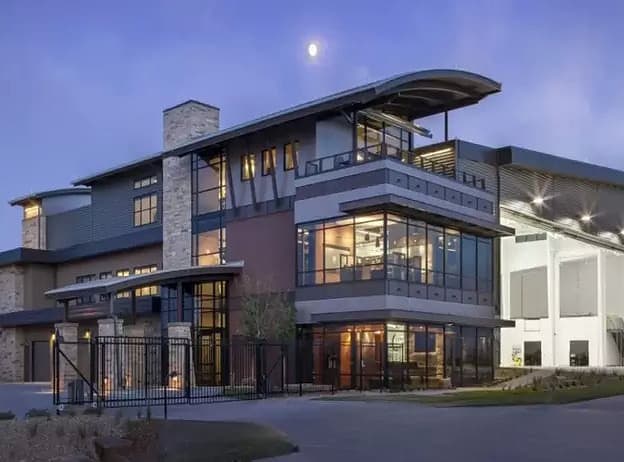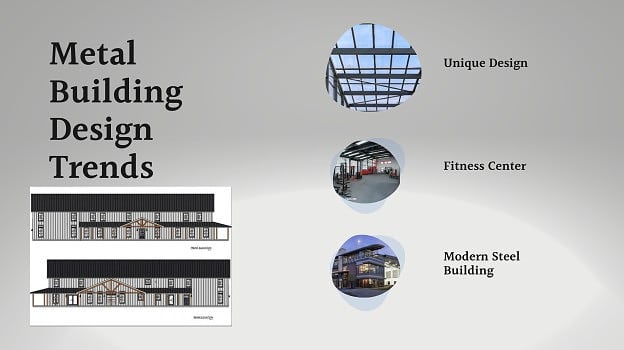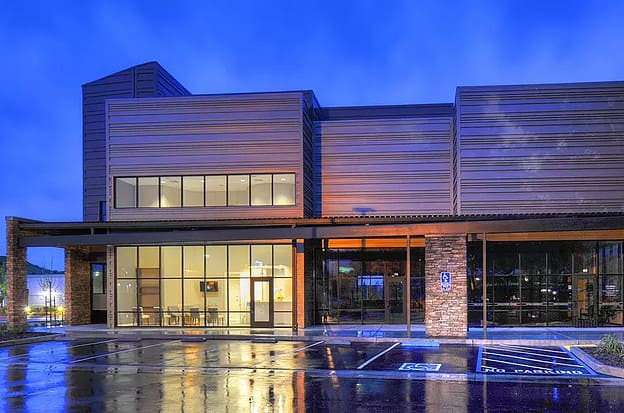Introduction
At First Choice Carports, we pride ourselves on staying ahead of the curve when it comes to metal building design trends. As we enter 2023, we are excited to share with you the top trends that will shape the metal building industry this year. From innovative materials to cutting-edge design techniques, this comprehensive guide will provide you with valuable insights to elevate your metal building projects to new heights.
1. Sustainability and Green Building Practices
In recent years, there has been a growing emphasis on sustainability and environmentally friendly practices in the construction industry. This trend extends to metal building design as well. More and more clients are seeking energy-efficient solutions that reduce their carbon footprint. Incorporating sustainable materials, such as recycled steel and eco-friendly insulation, into metal building projects has become a top priority.
2. Adaptive Reuse and Renovation
Metal buildings are known for their versatility, and in 2023, the trend of adaptive reuse and renovation continues to gain momentum. Instead of constructing new buildings from scratch, repurposing existing metal structures has become a popular choice. Whether it’s transforming an old warehouse into a trendy office space or converting a barn into a stylish event venue, adaptive reuse allows for creative and cost-effective solutions.
3. Advanced Roofing Solutions
The roof is an essential component of any metal building, and 2023 brings exciting advancements in roofing solutions. Standing seam metal roofs continue to dominate the market due to their durability and sleek appearance. Additionally, cool roofs with reflective coatings are gaining popularity as they contribute to energy efficiency by reducing heat absorption. These roofs not only enhance the overall aesthetics but also help lower cooling costs.
4. Integration of Smart Technology
The integration of smart technology has revolutionized various industries, and the metal building sector is no exception. In 2023, we can expect to see increased adoption of intelligent building systems. From automated lighting and HVAC controls to real-time monitoring and predictive maintenance, smart technology enhances the functionality, efficiency, and security of metal buildings.
graph LR A[Smart Technology Integration] B[Automated Lighting and HVAC Controls] C[Real-time Monitoring] D[Predictive Maintenance] A --> B A --> C A --> D
5. Biophilic Design
Biophilic design, which aims to incorporate elements of nature into built environments, is gaining traction in the metal building industry. By integrating natural materials, daylighting strategies, and indoor greenery, metal buildings can create a more harmonious and visually appealing atmosphere. Biophilic design promotes occupant well-being, productivity, and connection with the surrounding environment.Biophilic design, which aims to incorporate elements of nature into built environments, is gaining traction in the metal building industry. By integrating natural materials, daylighting strategies, and indoor greenery, metal buildings can create a more harmonious and visually appealing atmosphere. Biophilic design promotes occupant well-being, productivity, and connection with the surrounding environment.
6. Modular and Prefabricated Construction
Modular and prefabricated construction methods have been steadily gaining popularity due to their efficiency, cost-effectiveness, and reduced construction timelines. In 2023, we anticipate increased utilization of these methods in metal building projects. Modular designs allow for greater flexibility and customization options while maintaining high-quality standards. Prefabrication streamlines the construction process and minimizes on-site waste.
7. Enhanced Natural Lighting
Natural lighting plays a crucial role in creating inviting and comfortable spaces. In 2023, the focus on maximizing natural light within metal buildings continues to grow. Design strategies such as large windows, skylights, and light shelves are employed to optimize daylight penetration while minimizing glare and heat gain. Harnessing natural light not only maximizes energy efficiency but also creates a pleasant and productive indoor environment for occupants.

8. Customization and Architectural Versatility
Gone are the days of cookie-cutter metal buildings. Today, clients seek unique and customizable structures that reflect their individuality. In 2023, architectural versatility and customization options will be at the forefront of metal building design trends. With advancements in computer-aided design (CAD) software and manufacturing technology, architects and builders can create bespoke metal buildings that cater to specific client requirements, whether it’s a striking facade, intricate detailing, or unconventional layouts.
9. Multi-Functional Spaces
Metal buildings are known for their flexibility and adaptability, and in 2023, the demand for multi-functional spaces within these structures is on the rise. Clients are seeking versatile buildings that can accommodate multiple uses, such as offices with integrated warehouse spaces, retail showrooms with storage facilities, or educational institutions with adaptable classrooms. The ability to optimize space utilization and provide seamless transitions between different functions makes metal buildings an attractive choice for diverse industries.
10. Aesthetics and Exterior Finishes

While functionality is paramount, aesthetics also play a significant role in metal building design. In 2023, there will be a strong emphasis on enhancing the visual appeal of metal buildings through innovative exterior finishes and architectural elements. From textured metal panels and bold color schemes to creative cladding materials and artistic facades, metal buildings are embracing design features that elevate their appearance and make a lasting impression.
Conclusion
As we’ve explored the top trends in metal building design for 2023, it’s clear that the industry is evolving rapidly to meet the demands of clients seeking sustainable, adaptable, and aesthetically pleasing structures. From incorporating sustainable practices and smart technology to embracing biophilic design and architectural versatility, metal buildings are at the forefront of modern construction.
By staying informed and implementing these trends, you can ensure that your metal building projects stand out in the market and meet the evolving needs of your clients. At Boss Buildings, we are committed to delivering cutting-edge solutions and exceptional quality in every project we undertake.
Now is the time to embrace these trends and unlock the full potential of metal building design in 2023.
Note: The information provided in this article is for informational purposes only. The opinions expressed are those of the author and do not necessarily reflect the views of Boss Buildings.
This comprehensive guide provides valuable insights into the top metal building design trends for 2023. By incorporating sustainable practices, embracing technology, and focusing on customization and versatility, you can ensure that your metal building projects outrank the competition and meet the evolving demands of the market. Stay ahead of the curve and elevate your metal building designs to new heights in 2023.
Frequently Asked Questions (FAQs)
- What are the top metal building design trends for 2023? In 2023, the top metal building design trends include sustainability and green building practices, adaptive reuse and renovation, advanced roofing solutions, integration of smart technology, biophilic design, modular and prefabricated construction, enhanced natural lighting, customization and architectural versatility, and a focus on aesthetics and exterior finishes.
- Why is sustainability important in metal building design? Sustainability is important in metal building design as it promotes energy efficiency, reduces carbon footprint, and contributes to a greener environment. By incorporating sustainable practices and materials, metal buildings can be more environmentally friendly and align with the growing demand for sustainable construction solutions.
- What is adaptive reuse in metal building design? Adaptive reuse refers to the practice of repurposing existing metal structures for different functions instead of constructing new buildings. It allows for creative and cost-effective solutions by utilizing the existing framework and infrastructure. Adaptive reuse is gaining popularity as it combines sustainability with the ability to transform and revitalize older metal buildings.
- Why are advanced roofing solutions significant in metal building design? Advanced roofing solutions, such as standing seam metal roofs and cool roofs with reflective coatings, are significant in metal building design because they provide durability, energy efficiency, and aesthetic appeal. These roofs offer long-term protection, reduce heat absorption, lower cooling costs, and contribute to the overall performance and sustainability of metal buildings.
- How does the integration of smart technology benefit metal building design? The integration of smart technology in metal building design brings numerous benefits. Automated lighting and HVAC controls enhance energy efficiency, real-time monitoring allows for proactive maintenance, and predictive maintenance systems optimize building performance and reduce downtime. Smart technology improves functionality, efficiency, and security in metal buildings, providing a modern and convenient user experience.
- What is biophilic design in metal building projects? Biophilic design incorporates elements of nature into metal building projects to create a more harmonious and visually appealing environment. It involves the use of natural materials, daylighting strategies, indoor greenery, and other nature-inspired elements. Biophilic design promotes occupant well-being, productivity, and connection with the surrounding natural world.
- Why is customization important in metal building design? Customization is important in metal building design because it allows clients to tailor the building to their specific needs and preferences. Whether it’s unique architectural features, personalized layouts, or special exterior finishes, customization ensures that the metal building stands out and aligns with the client’s vision and branding.
- What are the benefits of modular and prefabricated construction in metal buildings? Modular and prefabricated construction methods offer several benefits in metal buildings, including faster construction timelines, cost-effectiveness, reduced on-site waste, and enhanced quality control. These methods provide greater flexibility in design, enable efficient manufacturing processes, and allow for easy customization and scalability in metal building projects.
- Why is enhanced natural lighting desirable in metal buildings? Enhanced natural lighting is desirable in metal buildings as it creates a welcoming and comfortable indoor environment. Ample natural light improves occupant well-being, reduces the need for artificial lighting during the day, and can enhance the aesthetics of the space. By optimizing natural light through design strategies, metal buildings can achieve energy efficiency and a pleasant ambiance.
- How can I incorporate the latest metal building design trends into my projects? To incorporate the latest metal building design trends, stay informed about industry developments, collaborate with experienced architects and builders, and explore innovative materials and technologies. Consider the specific needs of your clients and how the trends align with their goals. By combining your expertise with the latest design


